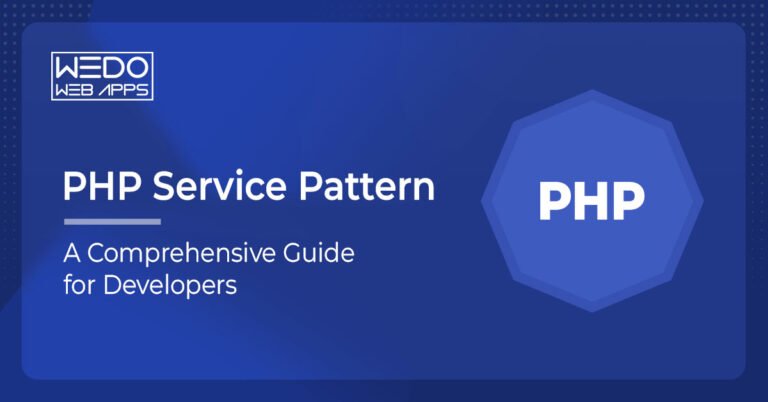1 Jun, 2023 | Web Development Company
PHP Service Pattern: A Comprehensive Guide for Developers

Is PHP in demand? Is it worth being a PHP developer in 2023?
Such queries are common among budding developers, especially after a slight decline of PHP-based websites in 2022, from 78.9% to 77.5% in 2023, per W3Techs report. However, PHP still has a fair share of holding in the market. Since it's faster, better, quick to learn, and flexible, it has broader scope among web developers. Also, the long list of PHP-based frameworks - Laravel, Symfony, CodeIgniter, CakePHP, Phalcon, and Laminas- can ensure that PHP is not going anywhere. The PHP community is constantly working to improve the framework and core PHP functionalities to make rich libraries for its dependent frameworks. In Dec 2022, PHP launched its latest version, 8.2, and its newer version targeting RFCs is set to be released by the end of 2023. So, all these facts answer well is PHP in demand. As several frameworks are based on PHP, the need for a structured approach to resolving common software design problems comes. PHP's design patterns and service patterns serve as a proven solution to this challenge. It helps developers in building maintainable, scalable, and reusable code for different use cases. This blog will guide you more about PHP service and design patterns.Is the PHP service pattern and PHP design pattern the same?
Each service pattern is a design pattern, but the opposite is untrue. An interesting fact is that service patterns are a subset of design patterns specifically focused on managing service dependencies. In contrast, design patterns cover a broader range of solutions to common design problems. If the service pattern is also a design pattern, how is it different? Let me tell you: PHP Design Patterns are reusable solutions to developers' common design problems during software development. These are code structuring patterns that aid scalability, flexibility, and maintainability. The broad categorisation of design patterns includes creational, structural, and behavioural patterns. Whereas the PHP service pattern is specific to service-oriented applications' specific design and architecture. It provides guidelines for designing and implementing services to achieve loose coupling, scalability, and interoperability. The terms PHP service patterns and PHP service layer patterns are often used interchangeably in PHP. Service patterns can refer to patterns such as Service Locator, Dependency Injection (DI), or Inversion of Control (IoC) containers. What is the difference between Service Locator, Dependency Injection (DI), and Inversion of Control (IoC) containers? Read on more to learn about each of these PHP service patterns.What is PHP service Pattern? What are their benefits?
It is a design pattern that focuses on organising and managing the business logic of an application. It helps separate the application's business logic from the presentation layer (user interface) and the data access layer. Moreover, it promotes the principle of "Separation of Concerns," where each application layer has specific responsibilities. When implementing the Service Pattern in PHP, you can create service classes that contain methods representing various operations and business logic. Then, the presentation layer can invoke these services to perform specific tasks.Benefits of using PHP service patterns
Business Logic Encapsulation:
The application's complex business logic and operation is contained in the service layer that abstracts it from the presentation layer. This interface provides a clean and organised way of interacting with the underlying business rules.Reusability and Modularity:
The business logic centralisation in a service layer lets you reuse the services across different application parts. Such a service pattern promotes modularity and minimises code duplication.Code Organisation:
It helps organise the application's logic into meaningful services. Each service focuses on a specific domain or functionality, making the codebase more maintainable and understandable.Dependency Management:
The Service Layer can manage the dependencies the business logic requires. This can include interactions with data repositories, external services, or other dependencies. It helps decouple the business logic from the underlying implementations, promoting flexibility and testability.Business Rules Enforcement:
Consider the service layer as a central hub to enforce business rules and validations. It ensures that the application follows the defined rules and constraints, promoting consistency and integrity.List of PHP Service Patterns
Service Locator:
It manages and retrieves dependencies or services throughout an application. It provides a centralised registry or container for locating and accessing these services. Here's how the service locator pattern is implemented in PHP: [code] class ServiceLocator { private $services = []; public function addService($name, $service) { $this->services[$name] = $service; } public function getService($name) { if (isset($this->services[$name])) { return $this->services[$name]; } else { throw new Exception("Service '$name' not found."); } } } [/code] In this example, the ServiceLocator class serves as the registry or container for storing services. It provides methods to add services to the container (addService()) and retrieve services from the container (getService()). The service locator helps in decoupling components. However, it has some drawbacks, such as introducing hidden dependencies, which makes code less testable. Also, overreliance on this pattern can lead to service locator anti-pattern. Thus, modern PHP developers use dependency injection (DI) over service locator to gain better control over dependencies and explicit configurations.Dependency Injection:
Call it a service pattern in PHP that manages and injects dependencies into objects. Instead of objects creating their dependencies internally in DI, they are provided to them from external sources, typically through constructor or setter injection. This allows for more flexibility, as objects can easily be configured with different implementations of their dependencies. Sharing an example of constructor injection in PHP: [code] class UserService { private $userRepository; public function __construct(UserRepository $userRepository) { $this->userRepository = $userRepository; } // ... } [/code] In addition to constructor injection, DI can also be achieved through setter injection or interface injection, depending on the specific needs and design of the application. Applying DI principles in your PHP projects can improve code maintainability, reusability, and testability while achieving a more flexible and loosely coupled architecture.Inversion of Control (IoC):
IoC container is a design pattern closely related to the DI pattern and often used in conjunction. In IoC, object creation and dependency resolution control are inverted or transferred to an external entity or framework. Instead of objects creating and managing their dependencies internally, they rely on an IoC container or framework to provide the necessary dependencies. Here’s an example of IoC in PHP: [code] class UserService { private $userRepository; public function __construct(UserRepository $userRepository) { $this->userRepository = $userRepository; } // … } [/code] In this example, the UserService class has a dependency on the UserRepository class. The control of creating an instance of UserRepository is inverted to the caller or an IoC container. The caller or container is responsible for resolving the dependency and injecting it into UserService. Mastering the PHP service pattern is essential for developers, but practical application is key. Follow our step-by-step PHP project guide for hands-on experience and explore the Laravel PHP framework for robust web development solutions.Wrapping Up
That’s broadly everything about PHP service patterns. I hope we have answered the critical questions for you in the domain. Like to join the tribe of our experienced web developers and unlock better opportunities? You can explore our careers page and drop your resume. WeDoWebApps LTD is a PHP Development Agency serving clients across the globe. We would love to have you among us!Frequently Asked Questions
PHP is defined on its official website as a recursive acronym for PHP: Hypertext Preprocessor. It is primarily known for server-side scripting to develop dynamic websites in the web development industry. However, as an open-source, general-purpose scripting language, PHP is useful in many areas, like writing desktop applications, command line scripting, OS designing, etc.
Yes, of course! PHP handles server-side scripting, whereas Javascript handles client-side scripting. When their paths don’t cross, their collaboration delivers quality projects. Both of the languages are adaptable to work together as well as separately.
PHP is the general-purpose scripting language that powers web developers to create dynamic web pages and applications. At the same time, Core PHP is the backbone of all PHP-based frameworks. It includes all the foundational and essential components of the PHP language.
The answer to PHP vs MVC queries is that PHP is a general-purpose language, whereas PHP-MVC is an easy-to-understand MVC skeleton application. You can call MVC a barebone structure is written in purely Native PHP.

